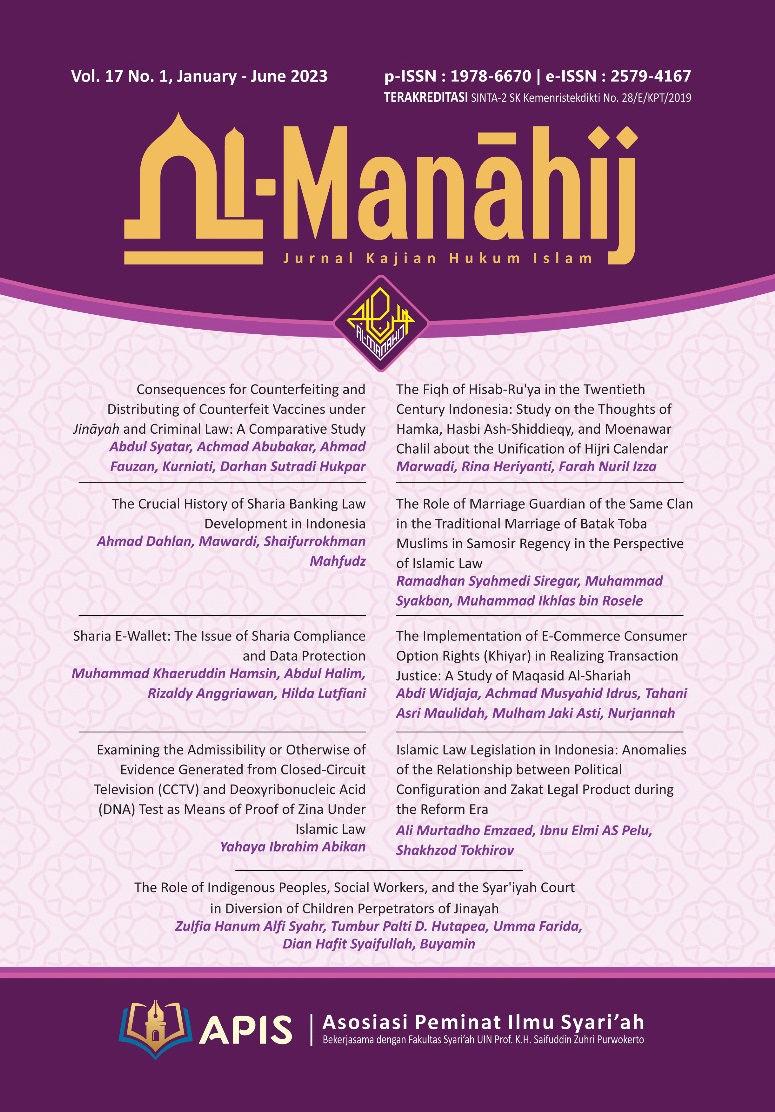Examining the Admissibility or Otherwise of Evidence Generated from Closed-Circuit Television (CCTV) and Deoxyribonucleic Acid (DNA) Test as Means of Proof of Zina Under Islamic Law
DOI:
https://doi.org/10.24090/mnh.v17i1.8172Keywords:
Closed-Circuit Television, Zina, Hudud, Islamic LawAbstract
This article examines the admissibility of evidence generated from CCTV and DNA tests as a means of proving adultery according to Islamic Law with a critical and argumentative study. This article reveals that hadd punishment cannot be imposed based on evidence generated from CCTV and DNA tests because the admission of such evidence will erode and neutralize the Qur'anic requirement of four reliable eyewitnesses before punishment. On the other hand, such evidence cannot be used to replace the provisions of the Qur'an and Sunnah because they are circumstantial and therefore subject to doubt. The author's main finding is that the only acceptable evidence for adultery is that prescribed by the Qur'ān or Sunnah, namely the oral testimony of four reliable eyewitnesses and confession. The article recommends that evidence generated from CCTV and DNA tests should be good evidence and equally admissible in all non-hudud offenses especially when there is no human interference or interruption tainting or affecting the evidence.Downloads
References
Agaba, James Atta. Practical Approach to Criminal Litigation in Nigeria (Pre-Trial & Trial Proceedings). LawLords Publications, 2011.
“Al-Qur’an Al-Kariim,” 2020.
Babaji, Bala. “Assessment of the Application of Hudud Punishments in Islam with Particular Reference to the Shari’ah Penal Code Laws of Some Northern States of Nigeria.” Journal of Islamic and Comparative Law 30, no. 1 (2015).
Bambale, Yahaya Yunusa. “Crimes and Punishments under Islamic Law,” 2003.
Bello, A. “Admissibility of Circumstantial Evidence in Hudud: Examining Pregnancy as Proof of Zina in the Sharia Courts of Northern Nigeria.” Manchester Journal of Transnational Islamic Law & Practice 16, no. 1 (2020): 112–42.
Contributor, TechTarget. “CCTV (Closed Circuit Television).” TechTarget, 2022.
Danjuma, Yusuf Ismail. “Closed-Circuit Television (CCTV) Camera as a Means of Proof in Islamic Penal System’ in Mansur Ibrahim Sa’id and Kabir Garba Muhammad (Eds.).” Legal Paradigm in Nigeria: A New Direction in the Study of Law and Practice. Nigeria, 2022.
Doi, Abdur Rahman I. Sharīʻah: The Islamic Law. Ta Ha Publishers, 1984.
Egbewole, Abdul Wahab. “Fundamental Human Rights in Nigeria’: A Myth or Reality.” 20th Annual Ramadan Lecture of the Muslim Lawyers’ Association of Nigeria (MULAN). Nigeria, 2017.
F.A.R. Adeleke. “CCTV Evidence Played to a Large Number of People Should Be Admissible for Application of Hadd Punishment.” Nigeria, 2022.
Garner, Bryan A. “Black’s Law Dictionary Eighth Edition, St.” Paul: West Thomson, 2004.
Goold, Benjamin J. “CCTV and Human Rights.” In Citizens, Cities and Video Surveillance: Towards A Democratic and Responsible Use of CCTV, Paris: European Forum for Urban Security, 2010.
Ismail, Wan Abdul Fattah Bin Wan, Ahmad Syukran Baharuddin, Lukman Bin Abdul Mutalib, and Mohamad Aniq Aiman Alias. “A Systematic Analysis on the Admissibility of Digital Documents as Evidence in Malaysian Syariah Courts.” Pertanika Journal of Social Sciences & Humanities, 2021.
Mahmud, Abdul Malik Bappa. “Supremacy of Islamic Law.” Huda-Huda Publishing Company, 1988.
Mish, Frederick C. “Webster’s Ninth New Collegiate Dictionary. Merriam-Webster.” Inc., Springfield, MA, 1991.
Morris, H F. “T. Akinola Aguda: The Law of Evidence in Nigeria.(Law in Africa, No. 22.) Xxxi, 403 Pp. London: Sweet and Maxwell; Lagos: African Universities Press, 1966. 90s.” Bulletin of the School of Oriental and African Studies 30, no. 3 (1967): 751–52.
Muhamad, Mohd Munzil bin, Ahmad Azam Mohd Shariff, Ramalinggam Rajamanickam, Mazupi Abdul Rahman, Anowar Zahid, and Noorfajri Ismail. “Qarinah: Admissibility of Circumstantial Evidence in Hudud and Qisas Cases.” Mediterranean Journal of Social Sciences 6, no. 2 (2015): 141.
Peiffer, Elizabeth. “The Death Penalty in Traditional Islamic Law and as Interpreted in Saudi Arabia and Nigeria.” Wm. & Mary J. Women & L. 11 (2004): 507.
Pereira, Charmaine. “Zina and Transgressive Heterosexuality in Northern Nigeria.” Feminist Africa 5 (2005): 52–79.
Pervin, Masuma. “Law of Murder under Islamic Criminal Law: An Analysis.” JL Pol’y & Globalization 53 (2016): 143.
Peters, Ruud, and Maarten Barends. “Islamic Criminal Law in Nigeria,” 2003.
Sa’id, Mansur Ibrahim. Islamic Criminal Law and Practice in Nigeria. Sokoto: Usman Danfodiyo University Printing Press, 2011.
Downloads
Published
How to Cite
Issue
Section
License
Copyright (c) 2023 Yahaya Ibrahim Abikan

This work is licensed under a Creative Commons Attribution-ShareAlike 4.0 International License.
Authors who publish with this journal agree to the following terms:
- Authors retain copyright and grant the journal right of first publication with the work simultaneously licensed under a Creative Commons Attribution License that allows others to share the work with an acknowledgement of the work's authorship and initial publication in this journal.
- Authors are able to enter into separate, additional contractual arrangements for the non-exclusive distribution of the journal's published version of the work (e.g., post it to an institutional repository or publish it in a book), with an acknowledgement of its initial publication in this journal.
- Authors are permitted and encouraged to post their work online (e.g., in institutional repositories or on their website) prior to and during the submission process, as it can lead to productive exchanges, as well as earlier and greater citation of published work (See The Effect of Open Access).


















